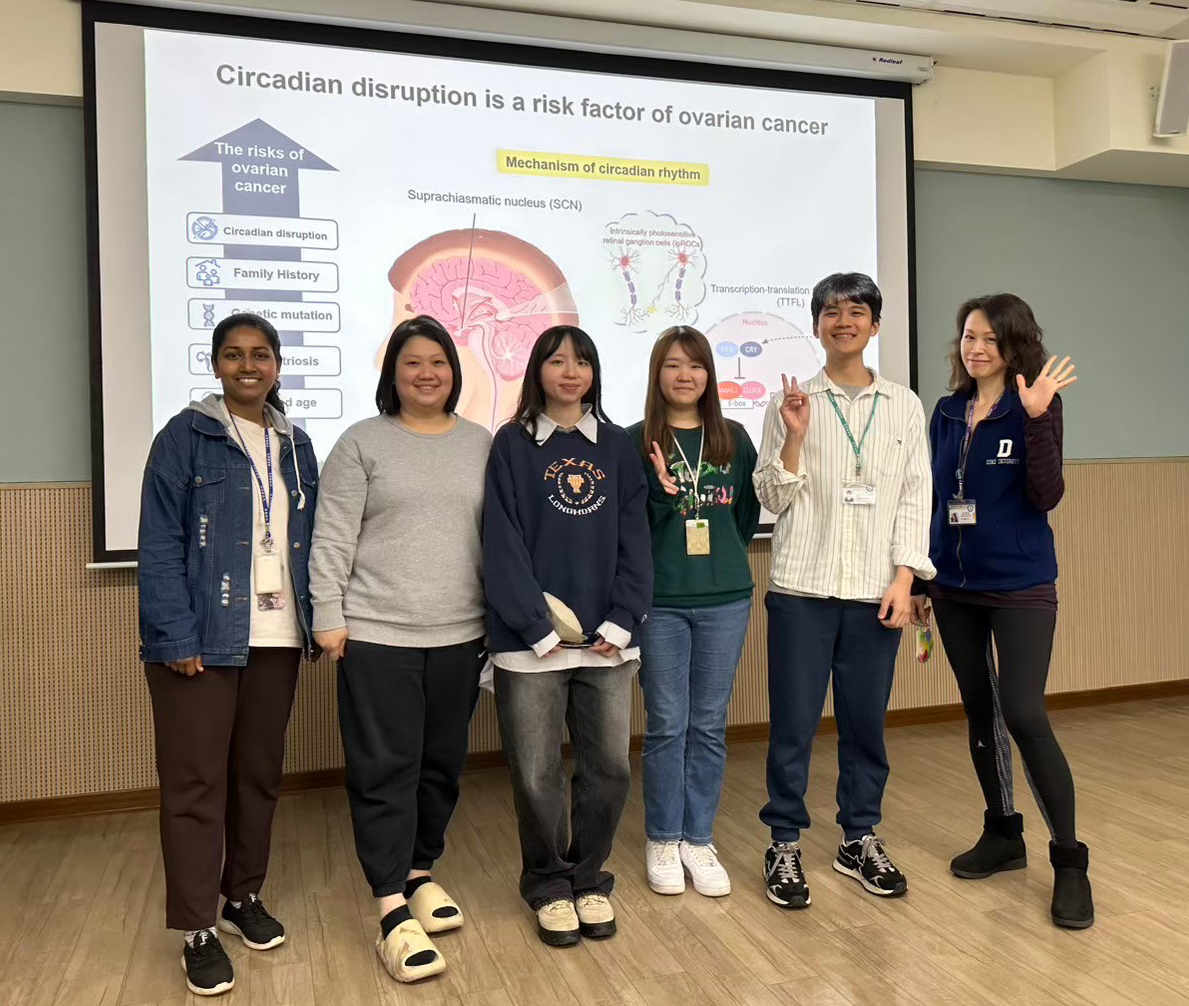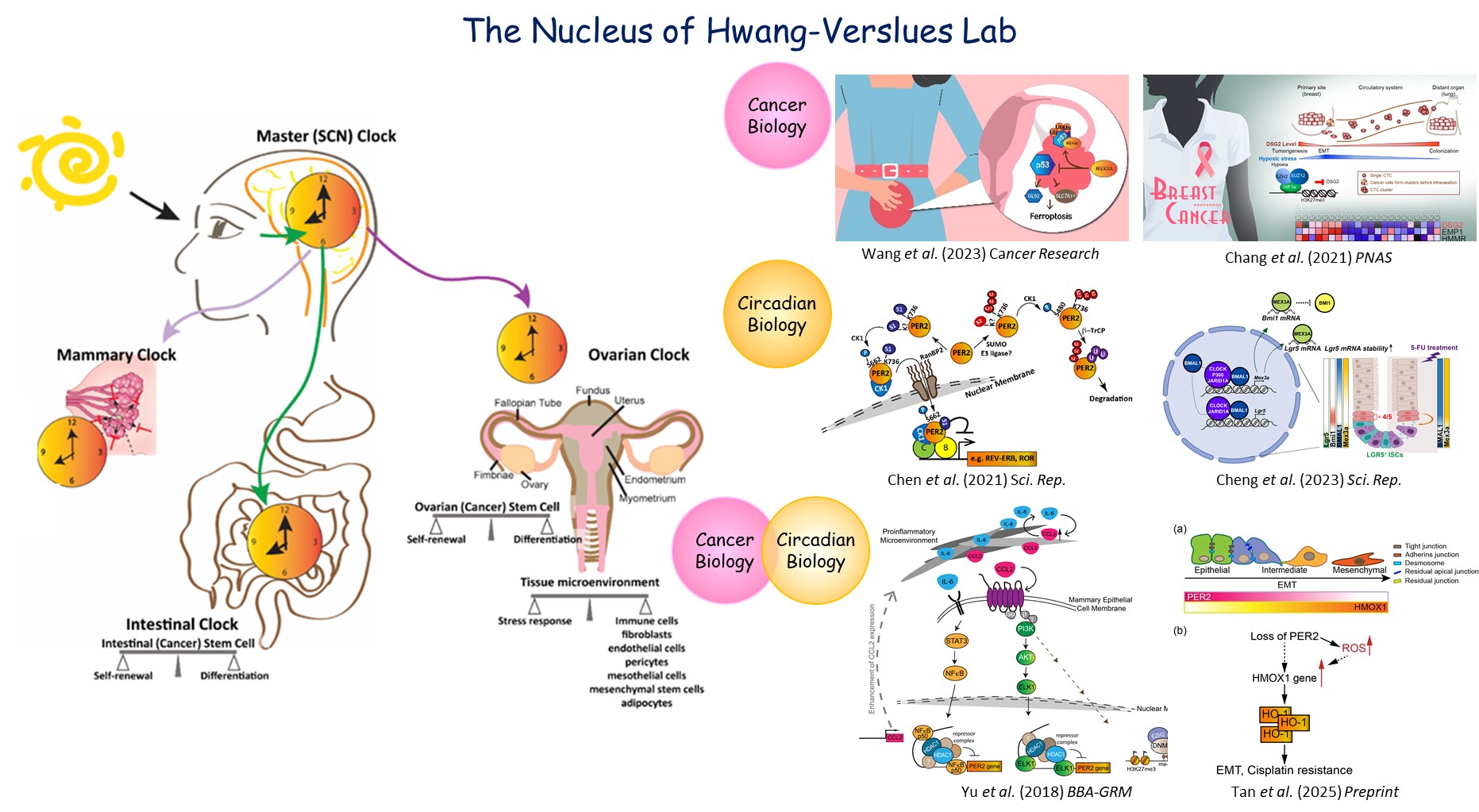| 姓名 | 黃雯華博士 |
|---|---|
| 現任 | 副研究員 |
| 所屬單位 |
卵巢癌、卵巢亮細胞癌、腫瘤微環境、癌症代謝、器官向性轉移、生理時鐘、BMAL1、BMAL2、PER2、時間療法。 Ph.D., Environmental Toxicology, University of California-Riverside, CA, U.S.A., 2002-2007 Master of Environmental Management, Duke University, Durham, NC, U.S.A., 2000-2002 Bachelor of Science, Department of Geography, National Taiwan University, Taipei, Taiwan, 1995-1999 |
| 名片 |
|
| 研究方向/領域 |
研究方向/領域黃雯華實驗室主要研究卵巢癌與乳癌,找出在腫瘤發生、惡化、轉移和復發過程中,至關重要的分子機制,以提供精準癌症醫學發展之基礎。我們發現MEX3A (具有RNA 結合與E3 連接酶雙功能之蛋白) 對卵巢腫瘤發生至關重要。MEX3A 介導的 p53 蛋白降解可抑制癌細胞鐵依賴型死亡 [Wang et al, Cancer Research, 2023]。此外,我們發現DSG2(可增強細胞之間粘附的橋粒蛋白)的表達與乳癌的不良預後和復發率高度相關。在乳癌進展過程中,DSG2的表現量會隨著微環境中的氧氣濃度,呈現動態變化。這些發現揭示了DSG2在乳癌轉移所有階段中的重要性,並提供了治療乳癌轉移的治療標的 [Chang et al, PNAS, 2021]。我們也發現生理時鐘核心基因PERIOD2(PER2)在乳癌及卵巢癌發生和惡化中,扮演重要角色 [Yu et al, BBA-GRM, 2018; Hwang-Verslues et al, PNAS, 2013; Preprint DOI:10.21203/rs.3.rs-5242949/v1]。
|
經歷
- 2023-Present, Associate Professor, Genomics Research Center, Academia Sinica, Taipei, Taiwan
- 2015-2023, Assistant Professor, Genomics Research Center, Academia Sinica, Taipei, Taiwan
- 2022-Present, Committee Member, Taiwan FDA Genetically Modified Foods Review Group, Taiwan
- 2022-Present, Committee Member, Academia Sinica Institutional Animal Care and Use Committee, Taiwan
- 2022-Present, Member, Academia Sinica Animal Experimentation Panel of Experts, Taiwan
- 2020-Present, Committee Member, Academia Sinica Institutional Review Board on Biomedical Science Research, Taiwan
- 2020-Present, Program Coordinator of Genomics Research Center (Academia Sinica)-China Medical University Cancer Biology Graduate Program, Taiwan
- 2017-Present, Adjunct Assistant Professor, Ph.D. Program for Cancer Molecular Biology and Drug Discovery, Taipei Medical University, Taiwan
- 2017-Present, Grant reviewer for National Science and Technology Council (NSTC), Taiwan
- 2017-2019, Keystone Symposia Programming Consultant Study Group member, USA
- 2017-Present, Member, Society for Research on Biological Rhythms, USA
- 2006-2007, Instructor, Department of Public Health, Loma Linda University, Loma Linda, CA, USA
- 2005-Present, Member, American Association for Cancer Research, USA
榮譽
- 2013, Postdoctoral Fellow Academic Publication Award, Taiwan National Science Council, Taiwan
- 2013, The 72nd Annual Meeting of the Japanese Cancer Association Travel Grant Award, Japan
- 2012, The 1st GRC Best Performance-and-Service Award, Genomics Research Center, Academia Sinica, Taiwan
- 2011, The 70th Annual Meeting of the Japanese Cancer Association Travel Grant Award, Japan
- 2010-2011, Academia Sinica Postdoctoral Research Fellowship, Taiwan
- 2008-2009, Academia Sinica Distinguished Postdoctoral Scholar Fellowship, Taiwan
- 2007, Sigma Xi Grants-in-Aid of Research Award, USA
- 2006, Fukuto Award, University of California-Riverside, USA
- Cheng L.-T., Tan G.Y.T., Chang F.-P., Wang C.-K., Chou Y.-C., Hsu P.-H., Hwang-Verslues W.W.*, 2023, “Core clock gene BMAL1 and RNA-binding protein MEX3A collaboratively regulate Lgr5 expression in intestinal crypt cells”, SCIENTIFIC REPORTS, 13, 17597. (SCIE)
- Wang C.-K., Chen T.-J., Tan G.Y.T., Chang F.-P., Sridharan S., Yu C.-H. A., Chang Y.-H., Chen Y.-J., Cheng L.-T., Hwang-Verslues W.W.*, 2023, “MEX3A mediates p53 degradation to suppress ferroptosis and facilitate ovarian cancer tumorigenesis”, Cancer Research, 83 (2), 251-263. (SCIE)
- Chen L.C., Hsieh Y.L., Tan G.Y.T., Kuo T.Y., Chou Y.C., Hsu P.H., Hwang-Verslues W.W.*, 2021, “Differential Effects of SUMO1 and SUMO2 on Circadian Protein PER2 Stability and Function”, SCIENTIFIC REPORTS, 11, 14431. (SCIE)
- Chang P.H., Chen M.C., Tsai Y.P., Tan G.Y.T., Hsu P.H., Jeng Y.M., Tsai Y.F., Yang M.H., Hwang-Verslues W.W.*, 2021, “Interplay between Desmoglein2 and hypoxia controls metastasis in breast cancer”, PROCEEDINGS OF THE NATIONAL ACADEMY OF SCIENCES OF THE UNITED STATES OF AMERICA, 118(3), e2014408118. (SCIE)
- Fararjeh, A., Tu, S.H., Chen, L.C., Cheng, T.C., Liu, Y.R., Chang, H.L., Chang, H.W., Huang, C.C., Wang, H.C.R., Hwang-Verslues, W.W., Wu, C.H., Ho, Y.S.*, 2019, “Long-term exposure to extremely low-dose of nicotine and 4-(methylnitrosamino)-1-(3-pyridyl)-1-butanone (NNK) induce non-malignant breast epithelial cell transformation through activation of the a9-nicotinic acetylcholine receptor-mediated signaling pathway”, ENVIRONMENTAL TOXICOLOGY, 34(1), 73-82. (SCIE)
- Yu, C.-W., Cheng, K.-C., Chen, L.-C., Lin, M.-X., Chang, Y.-C., Hwang-Verslues, W.W.*, 2018, “Pro-inflammatory cytokines IL-6 and CCL2 suppress expression of circadian gene Period2 in mammary epithelial cells”, BIOCHIMICA ET BIOPHYSICA ACTA-GENE REGULATORY MECHANISMS, 1861(11), 1007-1017. (SCIE)
- Abdul F.F.-S., Tu S.-H., Chen L.-C., Liu Y.-R., Lin Y.-K., Chang H.-L., Chang H.-W., Wu C.-H., Hwang-Verslues W.W., Ho Y.-S., 2018, “The Impact of the effectiveness of GATA3 as a prognostic factor in breast cancer”, Human Pathology, 80, 219-230. (SCIE)
- Wu YW, Hsu KC, Lee HY, Huang TC, Lin TE, Chen YL, Sung TY, Liou JP, Hwang-Verslues WW, Pan SL, Huang-Fu WC,, 2018, “A novel dual HDAC6 and tubulin inhibitor, MPT0B451, displays anti-tumor ability in human cancer cells in vitro and in vivo”, FRONTIERS IN PHARMACOLOGY, 9, 205. (SCIE)
- Huang S.-C., Wei P.-C., Hwang-Verslues W.W., Kuo W.-H., Jeng Y.-M., Hu C.-H., Shew J.-Y., Huang C.-S., Chang K.-J., Lee E. Y.-H. P., Lee W.-H.*, 2017, “TGF-β1 secreted by Tregs in lymph nodes promotes breast cancer malignancy via up-regulation of IL-17RB”, EMBO MOLECULAR MEDICINE, 9(12), 1660-1680. (SCIE)
- Cheung, S.K.C., Chuang, P.-K., Huang, H.-W., Hwang-Verslues, W.W., Cho C.H.-H., Yang, W.-B., Shen, C.-N., Hsiao, M., Hsu, T.-L., Chang, C.-F., Wong, C.-H., 2016, “Stage-Specific Embryonic Antigen-3 (SSEA-3) and β3GalT5 are Cancer Specific and Significant Markers for Breast Cancer Stem Cells”, Proceedings of the National Academy of Sciences of the United States of America, 113(4), 960-965. (SCIE)
- Wu, H.-H*, Hwang-Verslues, W.W.*, Lee, W.-H., Huang, C.-K., Wei, P.-C., Chen, C.-L. , Shew, J.-Y., Lee, E. Y.-H. P., Jeng, Y.-M., Tien, Y.-W., Ma, C., Lee, W.-H., 2015, “Targeting IL-17B/RB signaling with an anti-IL17RB antibody blocks pancreatic cancer metastasis by silencing multiple chemokines”, JOURNAL OF EXPERIMENTAL MEDICINE, 212(3), 333-349. (SCIE)
- Hwang-Verslues WW, Chang PH, Jeng YM, Kuo WH, Chiang PH, Chang YC, Hsieh TH, Su FY, Lin LC, Abbondante S, Yang CY, Hsu HM, Yu JC, Chang KJ, Shew JY, Lee EY, Lee WH, 2013, “Loss of corepressor PER2 under hypoxia up-regulates OCT1-mediated EMT gene expression and enhances tumor malignancy.”, Proceedings of the National Academy of Sciences of the United States of America, 110(30), 12331-6. (SCIE)
- Chang, P.-H., Hwang-Verslues, W.W., Chang, Y.-C., Chen, C.-C., Hsiao, M., Jeng, Y.-M., Chang, K.-J., Lee, E. Y.-H. P., Shew, J.-Y., Lee, W.-H., 2012, “Activation of Robo1 signaling of breast cancer cells by Slit2 from stromal fibroblast restrains tumorigenesis via blocking PI3K/Akt/β-catenin pathway”, CANCER RESEARCH, 72(18), 4652-4661. (SCIE)
- Hwang-Verslues, W.W.*, Lee, W.-H., Lee, E.Y.-H.P., 2012, “Biomarkers to target heterogeneous breast cancer stem cells (invited review)”, Journal of Molecular Biomarkers & Diagnosis, S8, 006.
- Hwang-Verslues, W.W., Chang P.-H., Wei P.-C., Yang C.-Y., Huang C.-K., Kuo W.-H., Shew J.-Y., Chang K.-J., Lee E.-Y., Lee W.-H., 2011, “miR-495 is upregulated by E12/E47 in breast cancer stem cells, and promotes oncogenesis and hypoxia resistance via downregulation of E-cadherin and REDD1”, ONCOGENE, 30(21), 2463-2474. (SCIE)
- Hwang-Verslues, W.W., Sladek, F.M., 2010, “HNF4a-role in drug metabolism and potential drug target? (review)”, CURRENT OPINION IN PHARMACOLOGY, 10(6), 698-705. (SCIE)
- Bolotin E., Liao H., Ta T.C., Yang C., Hwang-Verslues W.W., Evans J.R., Jiang T., Sladek F.M., 2010, “Integrated approach for identification of HNF4α target genes using protein binding microarrays”, HEPATOLOGY, 51(2), 642-653. (SCIE)
- Hwang-Verslues, W.W., Kuo W.-H., Chang P.-H. Pan C.-C., Wang H.-H., Tsai S.-T., Jeng Y.-M., Shew J.-Y., Kung J.T, Chen C.-H., Lee E. Y.-H. P., Chang K.-J., Lee W.-H., 2009, “Multiple lineages of human breast cancer stem/progenitor cells identified by profiling with stem cell markers”, PLoS One, 4(12), e8377. (SCIE)
- Hwang-Verslues, W.W., Chang, K.J., Lee, E.Y-H.P., Lee, W.-H., 2008, “Breast cancer stem cells and tumor suppressor genes”, Journal of Formosan Medical Association, 107(10), 751-766.
- Hwang-Verslues, W.W., Sladek, F.M., 2008, “Nuclear receptor HNF4alpha1 competes with oncoprotein c-Myc for control of the p21/WAF1 promoter”, MOLECULAR ENDOCRINOLOGY, 22(1), 78-90.
- Maeda, Y.*, Hwang-Verslues, W.W.*, Wei, G., Fukazawa, T., Durbin, M.L., Owen, L. B., Liu, X. and Sladek, F.M., 2006, “Tumor suppressor p53 down regulates the expression of the human hepatocyte nuclear factor 4alpha (HNF4a) gene”, BIOCHEMICAL JOURNAL, 400(2), 303-313. (SCIE)
Breast cancer:
https://www.scitw.cc/posts/hotnews16299
https://health.ltn.com.tw/article/breakingnews/3432015
Ovarian cancer:
https://www.sinica.edu.tw/tw/News_Content/36/528
Circadian and Cancer:
https://www.natgeomedia.com/science/article/content-9412.html
https://srbr.org/a-link-between-clocks-and-cancer/
https://investigator.tw/13082/





